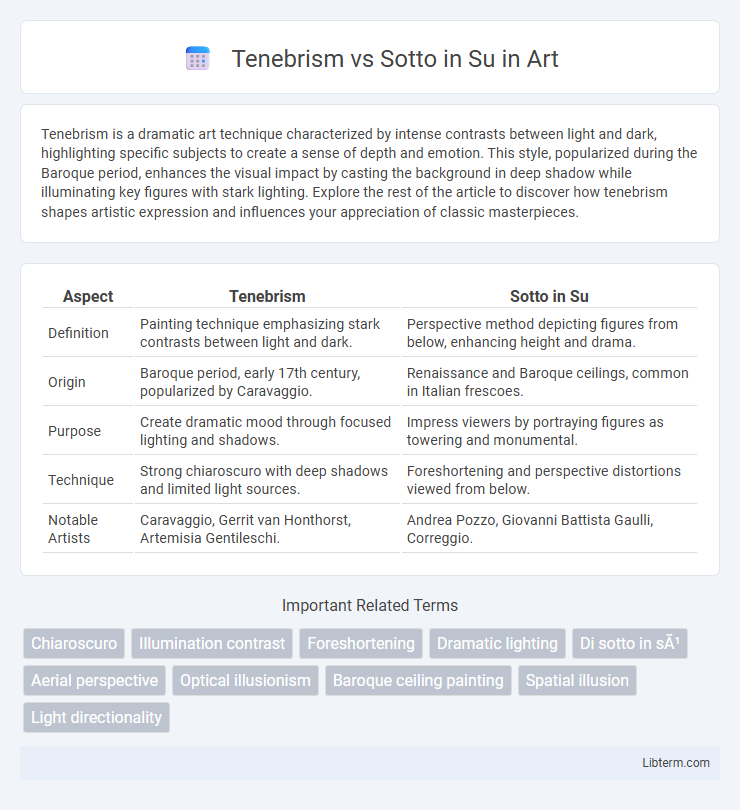Tenebrism is a dramatic art technique characterized by intense contrasts between light and dark, highlighting specific subjects to create a sense of depth and emotion. This style, popularized during the Baroque period, enhances the visual impact by casting the background in deep shadow while illuminating key figures with stark lighting. Explore the rest of the article to discover how tenebrism shapes artistic expression and influences your appreciation of classic masterpieces.
Table of Comparison
| Aspect | Tenebrism | Sotto in Su |
|---|---|---|
| Definition | Painting technique emphasizing stark contrasts between light and dark. | Perspective method depicting figures from below, enhancing height and drama. |
| Origin | Baroque period, early 17th century, popularized by Caravaggio. | Renaissance and Baroque ceilings, common in Italian frescoes. |
| Purpose | Create dramatic mood through focused lighting and shadows. | Impress viewers by portraying figures as towering and monumental. |
| Technique | Strong chiaroscuro with deep shadows and limited light sources. | Foreshortening and perspective distortions viewed from below. |
| Notable Artists | Caravaggio, Gerrit van Honthorst, Artemisia Gentileschi. | Andrea Pozzo, Giovanni Battista Gaulli, Correggio. |
Introduction to Tenebrism and Sotto in Su
Tenebrism is a dramatic painting technique characterized by stark contrasts between light and dark, emphasizing shadows to create a sense of volume and depth. Sotto in Su, translating to "from below upward," is a perspective style where the subject is viewed from beneath, making figures appear towering and dynamic in ceiling frescoes. Both approaches enhance spatial illusion but differ in their use of light and viewpoint to engage the viewer's perception.
Historical Origins of Tenebrism
Tenebrism originated in the early 17th century, primarily attributed to Italian Baroque painter Caravaggio, characterized by stark contrasts between light and dark to create dramatic intensity. This technique profoundly influenced European art by emphasizing a single light source that heightens emotional impact and three-dimensionality. In contrast, Sotto in Su, an illusionistic ceiling painting technique from the Renaissance, employs foreshortening and perspective without the intense chiaroscuro that defines Tenebrism.
Historical Development of Sotto in Su
Sotto in su, an Italian term meaning "from below, upward," developed during the Renaissance as a technique in ceiling fresco painting that creates the illusion of three-dimensional space when viewed from below. This perspective-driven method contrasts sharply with Tenebrism, which emphasizes dramatic chiaroscuro and stark contrasts between light and dark to create intense emotional impact. The historical development of Sotto in su reflects advancements in perspective theory and a growing fascination with spatial illusions, notably seen in works by artists like Andrea Mantegna and later Baroque painters.
Key Artistic Principles of Tenebrism
Tenebrism emphasizes dramatic contrasts between light and dark, creating a theatrical spotlight effect that highlights key subjects and evokes intense emotional responses. The technique employs sharp chiaroscuro effects with deep shadows and concentrated illumination to enhance volume and depth. This approach contrasts with Sotto in Su, which focuses on illusionistic ceiling paintings viewed from below, prioritizing perspective and spatial illusion over stark light-dark contrasts.
Defining Features of Sotto in Su
Sotto in su is a dramatic ceiling painting technique that creates an illusion of figures and architecture extending upward from the viewer's perspective, emphasizing foreshortening and dynamic spatial depth. It contrasts with tenebrism, which focuses on stark chiaroscuro and intense contrasts of light and shadow to heighten emotional impact. The defining features of sotto in su include extreme foreshortening, perspectival distortion, and the simulation of three-dimensional space on flat surfaces to immerse viewers in the depicted scene.
Visual Techniques: Light and Shadow
Tenebrism emphasizes stark contrasts between intense light and deep shadow, creating dramatic visual tension by isolating subjects against dark backgrounds. In contrast, the Sotto in Su technique employs upward perspective with softer, diffused lighting to enhance the illusion of depth and three-dimensionality on ceilings. Both methods manipulate light and shadow but differ in purpose: Tenebrism highlights emotional intensity, while Sotto in Su enhances spatial immersion.
Notable Artists and Masterpieces
Tenebrism, characterized by dramatic contrasts of light and dark, is exemplified by Caravaggio, whose masterpiece "The Calling of Saint Matthew" showcases intense chiaroscuro to evoke emotional depth. Sotto in Su, meaning "seen from below," is a ceiling painting technique famously utilized by Andrea Pozzo, whose work in the Church of St. Ignatius in Rome creates an illusionistic architectural extension through masterful foreshortening. These techniques represent distinct artistic approaches, with Tenebrism focusing on heightened realism through darkness and Sotto in Su emphasizing spatial illusion from a viewer's perspective below.
Emotional Impact and Viewer Experience
Tenebrism's intense chiaroscuro contrasts create stark emotional drama by emphasizing light and shadow, drawing the viewer into a scene of heightened tension and psychological depth. In contrast, Sotto in Su employs upward perspective foreshortening, generating an immersive, awe-inspiring experience that manipulates spatial perception to evoke wonder and elevates spiritual or dramatic narrative impact. The emotional impact of Tenebrism centers on intimate, almost theatrical intensity, while Sotto in Su enhances the viewer's sense of being enveloped by or beneath a transcendent or monumental event.
Influence on Art Movements
Tenebrism, characterized by dramatic chiaroscuro and intense contrasts between light and dark, profoundly influenced Baroque artists, emphasizing emotional depth and realism in painting. Sotto in Su, a ceiling painting technique involving foreshortened figures viewed from below, significantly impacted Renaissance and Mannerist art by creating immersive, illusionistic spatial experiences. Together, these approaches shaped subsequent art movements by advancing techniques in perspective, drama, and spatial dynamics that artists from Neoclassicism to Romanticism adapted for expressive purposes.
Tenebrism vs Sotto in Su: Key Differences and Legacy
Tenebrism emphasizes stark contrasts between light and dark to create dramatic, focused scenes, originating from Caravaggio's Baroque style. Sotto in Su uses foreshortening and upward perspective techniques to produce an illusion of three-dimensional space on ceilings, popularized in Renaissance and Baroque frescoes. The legacy of Tenebrism lies in its emotional intensity and chiaroscuro mastery, while Sotto in Su advances spatial realism and immersive viewer experience in architectural contexts.
Tenebrism Infographic

 libterm.com
libterm.com